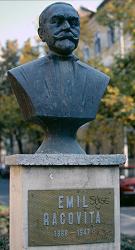Emil Racoviţă
1868-1947


Emil Racoviţă is the founder of speleological research in Romania. His name is also written Racovita or Racovitza. He was a scientist interested in the geology, but mainly in the biology of caves. He was a famous biologist and botanist and teached at the University of Klausenburg (Cluj).
The family of Emil Racoviţă was a famous aristocratic family. Various relatives of him, Mihai Racoviţă, Constantin Racoviţă and Ştefan Racoviţă inherited the Walachian or the Moldovan throne. Despite the wish of his father, he might become a lawyer, he graduated in zoology at the Faculty of Science on the Sorbonne. He became famous for his excellent Doctor thesis and for the results of the Belgian Antarctic Expedition (1897 to 1899) where he participated.
In 1904 he visited the famous
 Cuevas del Drach
on Mallorca, Spain.
After a new species of cave crustaceans was found in this cave he cought fire and dedicated his life to the biospeleology (cave biology).
He initiated an international research program called biospeologica.
By the way: this is not a mispelling: he omitted an "le" from biospeleology, to make the word easier to say and write.
And until today the Romanian word for speleology is speology in his honour.
Cuevas del Drach
on Mallorca, Spain.
After a new species of cave crustaceans was found in this cave he cought fire and dedicated his life to the biospeleology (cave biology).
He initiated an international research program called biospeologica.
By the way: this is not a mispelling: he omitted an "le" from biospeleology, to make the word easier to say and write.
And until today the Romanian word for speleology is speology in his honour.
Racovita was a renowned scientist and famous speleologist, and last but not least an early and active cave environmentalist. He worked at Klausenburg, today called Cluj, and was Director of the Speological Institute for 27 years (1920-1947).
Biography
| 15-NOV-1868 | born in Iaşi, Romania. |
| 1886-1991 | student at the Sorbonne University in Paris. |
| 1897 | member of the Belgian expedition to Antarctica. |
| 1920 | founded the Institutul de Speologie (Institute of Speleology) at the University of Klausenburg. |
| 1926-1929 | president of the Romanian academy of sciences. |
| 17-NOV-1947 | died in Cluj, Romania. |
Bibliography
- Emil Racoviţă (1900):
La vie des animaux et des plantes dans l’Antarctique,
- Emil Racoviţă (1907):
Essai sur les problemes biospeologiques,
- Emil Racoviţă (1927):
Speologia,
- Emil Racoviţă (1929):
Evoluţia şi problemele ei,
- Emil Racoviţă (1960):
Dem Süden entgegen - Durch Patagonien zum Südpol,
Bukarest, Jugendverlag 1960
(
 )
)
 Search DuckDuckGo for "Emil Racoviţă"
Search DuckDuckGo for "Emil Racoviţă" Emil Racovita - Wikipedia (visited: 24-JUN-2011)
Emil Racovita - Wikipedia (visited: 24-JUN-2011) EMIL RACOVITA referat (visited: 24-JUN-2011)
EMIL RACOVITA referat (visited: 24-JUN-2011) Index
Index Topics
Topics Hierarchical
Hierarchical Countries
Countries Maps
Maps